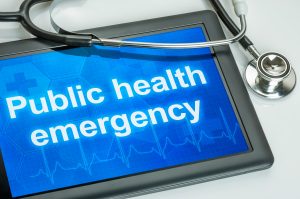September 2022
Inside This Issue
The September issue of Perspectives is again quite brief, which normally might give readers an opportunity to ease back into their autumn schedule. However, the big news this month is in our CMS section as CMS is starting to advise the industry to plan for the end of the public health emergency.
Sentinel Events: 
The lead article in Perspectives is about the first half year’s statistics on sentinel events, including volume of sentinel events identified and major categories of sentinel events. Data on most frequently reported root causes is not presented in this article. In terms of total volume of sentinel events identified, there was a large spike in reporting in 2021 as compared to 2020 and 2019.
In 2021, TJC obtained 1,208 sentinel event reports or analyses, whereas in 2020 it was only 809 and in 2019 only 910. There were pandemic spikes in inpatient utilization in both 2020 and 2021, but it is not clear why there was a 25% spike in sentinel events in 2021. At present there have been 752 sentinel events identified in the first 6 months of 2022, which if the pace continues would exceed the 2021 volume.
The article contains a second table listing the most frequently reported types of sentinel events in 2021 compared with the first half year of 2022. These numbers puzzled us initially because it shows the categories of sentinel events identified in 2022 as a small fraction of what was reported in 2021. But when we tallied up the total in 2022 it amounted to only 355 sentinel events, which leads us to believe it is only a subset of total reporting, probably showing only those events already fully analyzed by TJC staff with organizations.
As always, knowing the types of sentinel events others are experiencing is a learning opportunity and an opportunity for process redesign for enhanced safety.
Climate Pledge: 
Perspectives this month mentions that TJC has signed onto the White House and HHS’ Healthcare Sector Climate Pledge. This pledge is a commitment by healthcare organizations to reduce emissions by 50% by 2030 and to be net zero emissions by 2050. The White House has a press release on this initiative that can be accessed using this link: https://www.whitehouse.gov/briefing-room/statements-releases/2022/06/30/fact-sheet-health-sector-leaders-join-biden-administrations-pledge-to-reduce-greenhouse-gas-emissions-50-by-2030/
The article we discuss in the EC News section of this newsletter relative to Heat Emergencies does mention an Emergency Management issue that could potentially be probed and cited at this time.
Health Care Worker Well Being: 
The September issue of Perspectives has an article of importance on health care worker well-being, starting with a discussion of the surgeon general’s recently released report “Addressing Health Worker Burnout.” This report from the surgeon general can be downloaded from: https://www.hhs.gov/surgeongeneral/priorities/health-worker-burnout/index.html
The surgeon general’s report addresses the stress placed upon healthcare workers by the pandemic and offers suggestions on what providers, insurers, governments and accreditors can do to help ease some of that stress. Page 30 of the surgeon general’s report contains multiple weblinks to resources that organizations might find useful to address this issue.
TJC in their Perspectives article also announced that they have created another of their patient safety topic resources addressing workforce safety and well-being. The advice from the surgeon general and the TJC resources should prove useful to organizations as you begin to analyze the severity of the issues at your own organization and plan for improvements.
History & Physicals: 
This month’s Consistent Interpretation column discusses MS.03.01.01, EPs 6, 7 and 8 which require the medical staff to specify the minimum content for a history and physical (EP 6), to monitor the quality of histories and physicals (EP 7) and to ensure that privileged providers perform the H&P and its updates (EP 8).
We were surprised at the low volume of scoring these three elements of performance, 1.07% of surveys, 0.57% and 0.21% of surveys respectfully. We used to see EP 7 scored fairly often as a double ding, when surveyors found defects in implementation of the requirements for a complete H&P. The guidance TJC published in this article relative to EP 7 on medical staff oversight of the quality of H&Ps contains some peculiar new information. TJC states here that “Reviewing audit data conducted by nonclinical staff, such as HIM staff, does not meet the intent of this EP.”
We would agree that a routine HIM audit for medical record close out in 30 days after discharge would not meet this expectation. But in our experience, we commonly see the medical staff work with HIM to design an H&P audit using medical staff approved criteria and then review data collected by HIM staff using the medical staff approved audit criteria. If you are using HIM staff to collect data on the quality of H&Ps we would suggest verifying that the measures are actually selected by the medical staff and data collected is reviewed by the medical staff.
Another option is to consider building history and physical review into your OPPE process and have the review actually conducted by a peer. The guidance on EP 8 is worth taking a look at also relative to privileges for performing a history and physical. The surveyor observation and the TJC guidance both specifically address anesthesia providers performing a history and physical and/or update, however we would encourage readers to look at this EP more generally as it requires the person performing a history and physical or update to have privileges to do so.
Despite the very limited scoring from TJC, we do see a potential vulnerability quite often on consults where a privilege to perform a history and physical does not actually exist. As this is often considered a basic duty for a physician this could of course be embedded in a narrative of core privileges, or issued as a delineated privilege, but it should be listed if the practitioner wants to perform H&Ps or updates.
New Infection Prevention & Control Requirements: 
The last page of Perspectives always mentions issues that are in development for new or revised standards. We noted that this month they mentioned that they are working on new infection prevention and control requirements for all accreditation programs. As the IC chapter has garnered significant RFI scoring and adverse decisions in recent years, we would encourage our readers to be on the lookout for upcoming announcements relative to these changes.
TJC usually provides accredited organizations the opportunity to comment through a field review on potential standards changes, although sometimes the turnaround expectation is short. Given the importance of this chapter you will want to ensure that your team has an opportunity to review and provide feedback to help shape these changes to the extent possible.
Extreme Heat and Power Outages: 
This month’s EC News has an article entitled “Grappling with Extreme Heat,” which many of us have experienced this summer. We noted a specific advisory in this article to be sure to address extreme heat in the development of your hazard vulnerability analysis for EM.11.01.01 as well as the mitigation and preparedness actions in this same standard. These standards just became applicable July 1st and we noted that the published version does not specifically discuss extreme heat.
As we have gone around the country, we see many similar HVA templates that organizations have identified from publications, web resources or personal development. Some of these tools do include a reference to temperature extremes, but not all do. We commonly see this addressed in organizations located in the southwestern US, but it sounds like something they desire to see addressed more universally. As TJC gets more involved in the climate pledge and its initiatives, this will likely undergo greater scrutiny in the review of your EM documentation.
The article drifts into a discussion of NFPA standards for utility systems that need to be considered in the event of a power loss or brownout that is becoming more common in some areas. As you incorporate consideration of heat emergencies into your EM planning, the corresponding utility systems and processes needed to mitigate the impact of such power losses will need to be incorporated in your planning.
The same EC News article on extreme heat also advises that OSHA in late 2021 published notice that they intended to develop rules for Heat Injury and Illness Prevention in the Federal Register. This still appears to be a work in progress, but at the time the notice was first published OSHA did summarize examples of existing state rules on prevention of heat injury.
California in particular seems to be ahead of the curve on the development of such rules, although they do not specifically reference the healthcare industry and an applicable industry for their rules. You can review the California heat injury rules here: https://www.dir.ca.gov/title8/3395.html
Decarbonizing the Health Care Sector: 
New leaders create new priorities and focus areas and it is clear that the new President at The Joint Commission is leading the organization in new directions based on what issues we see being discussed in their publications.
Prior to the last few months, we don’t recall reviewing anything from TJC relative to climate change, carbon or heat emergencies. This month EC News has yet another article on reducing carbon emissions, spotlighting the Kaiser Permanente healthcare organization. The authors identified that 2/3 of their energy use was for HVAC and they discuss methods they have used to try and reduce energy consumption by balancing air exchanges with enhanced filtration.
As reduced energy consumption has both reduced carbon emission and cost saving potential, it is worth sharing with your facilities team.
EC Risk Assessments: 
The last article in EC News we should discuss is another one of their toolbox articles, this time on EC risk assessments. While this promotes a new JCR publication, their attached tool is certainly worth consideration for use.
The authors highlight seven (7) elements of performance that call for environmental risk assessments, the first of which is quite general and their attached tool is a good example of one to conduct this broad environmental risk assessment. The other specific elements of performance they reference in the article include:
- 02.01.01, EP 1: General environmental risk assessment that could affect patients, staff or other visitors. The tool, they attached is a good example of a broad based, general, EC risk assessment.
- 02.01.01, EP 17: Annual worksite analysis related to workplace violence.
- 02.05.02, EP 2: Water risk management plan
- 02.06.05, EP 2: Preconstruction risk assessment
- 02.03.01, EP 11: Surgical fire risk assessment
- 15.01.01, EP 1: Environmental risk assessment for suicide hazards
- 02.02.01, EP 5: Minimize hazards with hazardous chemicals. The risk assessment component is to know what chemicals are in use, determine how staff use that chemical, analyze the hazard and mitigate the risk.
Bear in mind that this article only discusses the EC chapter, and the concept of risk assessment is very widespread throughout the standards. If you search electronic versions of the standards for the term “risk” you will find many pages of references from infection control risk assessments to fall risk assessments to anesthesia risks, high risk procedures, maternal hemorrhage risks, and many others.
There is one other consideration relative to risk assessment we should discuss and that is the concept of conducting a targeted, or issue specific risk assessment when you identify something that subjectively could be a risk, but based on your analysis of amount of risk, existing safeguards, and evidence that the potential hazard has never led to an actual problem, you decide to do nothing about the potential risk.
Potential risks that are perceived by a surveyor to present actual risk can still be scored. If you get into such a subjective discussion with a surveyor and you say “but it has never presented a problem,” the surveyor is likely to say: “oh, did you do a risk assessment?” If you discount the potential risk in your head and fail to involve others, and document your thought process, you can still get scored with a finding if there was no formal, documented risk assessment.
Think of some very general requirements such as “adequate lighting,” “tripping hazards,” “good condition.” Opinion could play a role in a surveyor’s conclusion about the adequacy of your approach to a situation. If you have previously questioned the adequacy, and documented you analyzed it and reached a conclusion in a documented risk assessment that it was genuinely adequate, then it is much less likely to be scored as a hazard. The use of references, data from your own experience, and a multidisciplinary team process are elements we would recommend when conducting such risk assessments.
CMS posted two issues during the past month, one QSO memo applicable to hospitals and a blog posting advising the health care industry to prepare for the end of the public health emergency.
EMTALA and Abortion in Texas: 
The QSO memo is QSO-22-23, relative to EMTALA and abortion but it applies only to Texas. This limited applicability results from court action in that state. Those organizations in Texas should discuss the potential implications of the EMTALA and court requirements with their attorneys. The QSO memo can be downloaded from: https://www.cms.gov/medicareprovider-enrollment-and-certificationsurveycertificationgeninfopolicy-and-memos-states-and/preliminary-injunction-texas-v-becerra-no-522-cv-185-h-nd-tex
Public Health Emergency Ending?
 The blog posting is probably the most interesting and important issue we discuss this month. Most organizations have a process to periodically search for new QSO memos but the CMS blog post, which is somewhat like a press release, is an announcement you may have missed and it is a very important subject. You can view the blog here: https://www.cms.gov/blog/creating-roadmap-end-covid-19-public-health-emergency
The blog posting is probably the most interesting and important issue we discuss this month. Most organizations have a process to periodically search for new QSO memos but the CMS blog post, which is somewhat like a press release, is an announcement you may have missed and it is a very important subject. You can view the blog here: https://www.cms.gov/blog/creating-roadmap-end-covid-19-public-health-emergency
The blog advises the healthcare industry that the public health emergency is going to end at some point in the near future. CMS states that the HHS Secretary will provide the industry with at least a 60-day notice before ending the PHE. The blog discusses regulatory flexibilities that have been in place and the work that is being done to continue some flexibilities and the eventual elimination of other flexibilities.
The key message for providers is that it is time to start planning for unwinding some practices that have developed during the PHE. CMS provided links in their blog to more detailed guidance for different types of providers and we have included the links at the end of this section specifically developed for hospitals/CAHs and teaching hospitals.
In the 28-page hospital memo, CMS discusses many regulatory waiver issues and enhanced payment mechanisms that have been in place throughout the PHE. CMS provides guidance in the hospital memo on what is likely to continue and what is likely to go away after the PHE.
This detailed memo should be reviewed very carefully by clinical and financial leadership so that you can plan to be compliant with previously waived requirements and ensure continued payments for services you have been providing or modification of service arrangements. For example, CMS provides guidance on how they will be reimbursing or not, for Covid vaccines, monoclonal antibodies, remdesivir, and services provided at temporary expansion sites.
CMS also provides guidance on flexibilities that are planned to end such as CAH bed count, off site patient screening, alcohol-based hand rub quantity waivers, discharge planning, verbal orders, nursing care plans and many other issues. Going back and restarting practices that were ceased because they were thought to be nonessential will be a difficult task with a workforce that may still be stressed from the pandemic, resignations and retirements.
Hospital and CAH detailed guidance: https://www.cms.gov/files/document/hospitals-and-cahs-ascs-and-cmhcs-cms-flexibilities-fight-covid-19.pdf
Teaching Hospitals, teaching physicians and residency training detailed guidance: https://www.cms.gov/files/document/teaching-hospitals-physicians-medical-residents-cms-flexibilities-fight-covid-19.pdf
Consultant Corner
Dear Readers,
We have some very exciting news – our team has grown again!
It comes with great pleasure to announce that Barrins & Associates, a well-established and highly respected consulting firm providing accreditation and regulatory compliance consulting for behavioral healthcare organizations, has joined the HBS and Patton Regulatory and Compliance team! We have had the honor and privilege working with Anne Barrins and her team for many years and their extensive experience leading successful regulatory compliance programs will allow us to expand our service line to better assist you.
Please read the full Press Release for more information!
Jennifer Cowel, RN MHSA
JenCowel@PattonHC.com
Kurt Patton, MS RPh
Kurt@PattonHC.com
John Rosing, MHA
JohnRosing@PattonHC.com
Mary Cesare-Murphy, PhD
MCM@PattonHC.com
